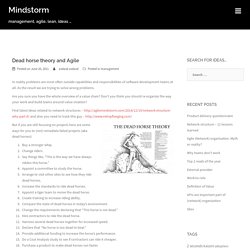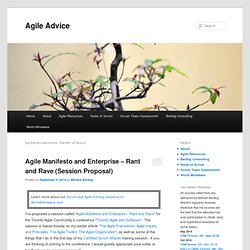

Dead horse theory and Agile « Management « Agile Mindstorm. In reality problems are most often outside capabilities and responsibilities of software development teams at all.

As the result we are trying to solve wrong problems. Are you sure you have the whole overview of a value chain? Don’t you think you should re-organize the way your work and build teams around value creation? Find latest ideas related to network structures – and also you need to track this guy – But if you are still focusing on projects here are some ways for you to (not) remediate failed projects (aka dead horses): p.s. this great list is from Daniel Gullo in agile-leaders@googlegroups.com group that i read today. What Is Agile? (10 Key Principles of Agile)
What is agile?

Agile is one of the big buzzwords of the IT development industry. But exactly what is agile development? Put simply, agile development is a different way of managing IT development teams and projects. The use of the word agile in this context derives from the agile manifesto. A small group of people got together in 2001 to discuss their feelings that the traditional approach to managing software development projects was failing far too often, and there had to be a better way. Individuals and interactions over processes and tools Working software over comprehensive documentation Customer collaboration over contract negotiation Responding to change over following a plan That is, while there is value in the items on the right, we value the items on the left more.”
Ever since then, the use of methods that support these values has become increasingly popular. The Three Fundamental Principles of Agile Estimation – The Third One Will Surprise You! You probably already use an Agile Estimation technique such as the Planning Game or the Bucket System, but surprisingly few people understand the underlying principles of Agile Estimation.

This lack of understanding often causes confusion or stress for the people who try to use Agile Estimation techniques. The discrepancy between traditional estimation techniques and Agile techniques is large and it is hard to bridge that mental gap without understanding the principles involved. Theory of Agile.
This is “my” blog – I write most of the articles, and it is owned by the business in which I am a major partner.

I recently was reviewing comments in the moderation queue and came across this “gem”: This man is a scammer, agile snake oil only 600, what a bargain. Filthy scamming piece of crap, he’s probably stupid enough to believe his own s**t too. I’m assuming this person, who is anonymous, is upset either about something I said here on this blog, or possibly something that I (or one of my colleagues) did while we were working with one of our clients. Several months ago, I was also made aware of a posting about Berteig Consulting (and myself) on Ripoff Report. Our company undergoes Agile transformation.
Honestly, these sorts of comments make me a bit sad, a bit down. The Agile “Scam” Let’s make sure we know what we are talking about. The thing about values and principles is that they are a bit like axioms in formal logic: you can’t prove them. Agile - Theory vs. Practice. When does Agile fail?

I’ve worked on a number of Agile projects throughout my 13 year career, and my experience with agile has been bittersweet. I was thus quite excited by the opportunity to work with the geeks that literally wrote the book on agile, and have since gained a more well rounded understanding of the concepts and practices along with their pros and cons. I have come to believe that the main reason many efforts to go agile fail is because practitioners tend to forget that the manifesto is a statement of utopian ideals to aspire to. Any prescriptive practices that come out of it like Scrum and Kanban are simply practical attempts to stride towards this ideal however, due to the nature of the principle, none of these practices can ever actually get to the ideal. Some get nearer than others, but absolute agility can never be achieved in practice. In practice being agile is simply an optimal compromise with ambient constraints.
. #1 Transparency #2 Inspection #3 Adaptation. Antifragile: How to Live in a World We Don't Understand by Nassim Nicholas Taleb – review. 'Overconfidence': Nassim Nicholas Taleb.

Photograph: Murdo Macleod Bindweed is a thing of evil genius. Try to dig it up and it breaks into pieces, each of which will grow into a new plant. More than just robust or flexible, it actively thrives on disruption. Yet we lack a word for this property – which Nassim Nicholas Taleb describes as the exact opposite of fragility. Taleb argues that antifragility is essential for dealing with the subject of the book that made his name: black swans.